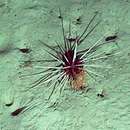Comprehensive Description
provided by Smithsonian Contributions to Zoology
Poriocidaris purpurata (Wyville Thomson)
Poriocidaris purpurata.—For a complete synonymy and additional description see Mortensen, 1928, p. 104.
The test is noticeably flattened adapically and adorally (Plate 11: figure 3), with well-rounded sides. Some specimens are widest high on the test, others widest at the midpoint. Commonly there is no incurving of the basicoronal plates at the edge of the peristome. A few specimens exhibit a slight tendency toward incurving.
The ambulacra are moderately sinuate, marginal tubercles in a uniform series, inner tubercles lacking or very scattered in the upper portion of the ambulacra (Plate 12: figures 6, 7). Below the ambitus the tubercles are more abundant but normally only one or rarely two per plate. Plates lacking inner tubercles are common throughout the ambulacra. Poriocidaris purpurata possesses the internal prolongation (Plate 10: figure 3) on the peristomial ambulacral plates common to the histocidarids.
The shallow areoles are very large, the scrobicular ring circling near all the plate sutures on plates at and above the ambitus (Plate 11: figures 1, 3). Only a few extra scrobicular secondary tubercles occur on these plates. Below the ambitus the extrascrobicular areas at each side of the areoles are relatively larger and are accompanied by a proportionate increase in secondary tubercles (Plate 11: figure 2). Primary tubercles are crenulate even below the ambitus but strongly crenulate on the uppermost two or three of each series.
Primary spines are 2 to 2.5 times the horizontal diameter of the test, are cylindrical or slightly tapering. A few specimens with a few well-developed thorns on some spines have been collected from the eastern Atlantic. Normally numerous very small ridges of spinules run the length of the shaft. The spinules are directed strongly toward the tip of the spine. The collar on the uppermost primary spines of some specimens extends for a considerable distance up the spine. Some spines with long collars have a swelling in the collar. Purple to brownish pigment is common in the collar but the shaft is usually white.
The oral primary spines are strongly serrated, broadly rounded at the tip (Plate 11: figure 6) transversely convex on the adapical side fiat on the adoral side. Longitudinally, these spines curve toward the mouth.
The most important diagnostic feature of P. purpurata is that its tridentate pedicellariae are bivalved and very strongly compressed (Plate 10: figure 2).
The color is quite varied. Specimens range from white to dark brownish purple test and secondary spines. The primary spine shaft is white, but the collar is the color of the test and secondary spines.
DISTRIBUTION.—South of Ireland to the Canary Islands. It was not previously known to occur in the western Atlantic. I discovered two specimens, one at the United States National Museum, the other at the Museum of Comparative Zoology at Harvard University. The specimen in the USNM (E-8244) was collected by RV Oregon at station 1909, 11 September 1957, 12°35'N, 82°19'W in the Caribbean Sea at 350 fms. The other specimen (MCZ 7732) was collected at Nicholas Channel off Bahia de Santa Clara at 500 fms, Atlantis station 3459.
COMPARISON WITH OTHER SPECIES.—The three histocidarids, Histocidaris nuttingi, H. sharreri, and Poriocidaris purpurata, can readily be (distinguished from the other cidaroids of the northwestern Atlantic, Caribbean, and Gulf of Mexico by the lack of globiferous pedicellariae. Internally all three of the histocidarids have a prolongation on the peristomial ambulacral plates (Plate 10: figure 3) lacking in the other cidaroids of this region. Crenulation is strong all around the upper primary tubercles and present on tubercles well below the ambitus on the histocidarids. There is varied development of crenulation among the other cidaroids of the region but on none of them does it extend below the ambitus.
The naked tests of H. sharreri and P. purpurata are similar. Both have very large areoles, scrobicular rings that crowd their plate sutures especially at and above the ambitus, and very few extrascobicular secondary spines and tubercles. There are only a few inner tubercles in the ambulacral midzone of each species; possibly slightly more on P. purpurata than on H. sharreri.
The ambulacral midzones of H. sharreri and P. purpurata have few inner tubercles, but the midline suture is almost hidden by the abundant inner tubercles on H. nuttingi. The marginal tubercles of H. sharreri and P. purpurata are arranged in a uniform size gradient throughout the ambulacra; small adapically on small plates larger at the ambitus. Histocidaris nuttingi has large marginal tubercles separated by smaller ones approximately the same size as the inner tubercles. The large marginal tubercles in each series of an ambulacrum form a zigzag pattern.
The large tridentate pedicellariae are a diagnostic feature on each of these species. Histocidaris sharreri has three very broad large valves on each of its large tridentate pedicellariae (Plate 12: figure 5), whereas those of H. nuttingi are very long and slender (Plate 15: figure 1). All the pedicellariae on P. purpurata have two highly compressed valves. The small tridentate pedicellariae of H. sharreri and H. nuttingi are similar.
The collar on the uppermost primary spines of all three of these histocidarids commonly extends far up the shaft. This feature was previously considered diagnostic for P. purpurata. Thorns are uncommon on the primary spines of P. purpurata, common on those of H. nuttingi, of uncertain occurrence on H. sharreri. Thorn occurrence on H. sharreri is discussed in the description of the primary spines of that species.
Poriocidaris purpurata is distributed from south of Ireland to the Canary Islands and in the Caribbean Sea at depths of approximately 750–1,800 meters.
- bibliographic citation
- Phelan, Thomas Francis. 1970. "A field guide to the Cidaroid echinoids of the northwestern Atlantic Ocean, Gulf of Mexico, and the Caribbean Sea." Smithsonian Contributions to Zoology. 1-67. https://doi.org/10.5479/si.00810282.40

